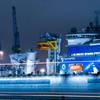It's As Close to the Real Thing as You Can Get and Still Stay Dry
By Larry Pearson
June 11, 2004 was a very big day for the advancement of maritime training as the Pacific Maritime Institute (PMI) introduced its full mission simulator in a new 15,000 sq. ft. building in Seattle, Wash.
Gregg Trunnell, PMI's director set the tone for the day when he said during dedication remarks, "Oceangoing vessels are not simple pieces of equipment and the days of cabin boys and shanghaied crew members are over. The rules, regulations and technological hurdles for deckhands, officers and pilots are becoming more complicated each year and certification requirements get more rigorous and time consuming with every level of advancement, requiring longer courses and more at-sea training hours."
Trunnell also noted that maritime schools are few and far between and often students had to travel to a number of states to get a single certification. "With the opening of this new facility, those days are gone forever for mariners in the Pacific northwest," Trunnell noted.
The Pacific Maritime Institute got its start in 1972 when the Maritime Institute of Technology and Graduate Studies (MITAGS), the training facility for the International Organization of Masters, Mates & Pilots took over the MARAD Radar School in Seattle, Wash. "Captain Bob Campion was the instructor and the school flourished until Captain Campion's death in the early 1990's and the school shut down," Trunnell said. In 1997, MITAGS hired Trunnell to reopen and relocate the school under the direction of Glen Paine, executive director of MITAGS. "Since then we have grown from being a radar school offering one program to a fully functional comprehensive maritime training campus," Trunnel added. The new Full Mission Simulator is the crown jewel in the new building housing PMI. The simulator was built by the Transas Group, Cork, Ireland. Transas is a worldwide company offering many types of simulators and other training aids for the international marine industry.
The Transas Full Mission Bridge Simulator consists of the full spectrum of navigational controls expected on a bridge including radar displays, ECDIS, vessel controls and navigational sensors, all of which are built in consoles. All related visual and sound effects are also incorporated into the simulator to create a realistic, professional simulated environment.
Main components of the simulator include the conning station, Electronic Chart Display and Information System (ECDIS), NavAids and Instrumentation Display, Bearing CCTV/2nd Conning Station, and a very realistic visual scene.
The Conning Station Display features the functionality and physical appearance of controls and indicators on real bridge Conning Stations. Skillfully reproduced hardware control modules such as sliding levers, switches, push buttons, analog and digital instrumentation readouts enhance the realism. A dedicated Mooring Operation Control Panel is provided with the simulator. All the stages of a mooring operation are realistically portrayed on the simulator. 0The ECDIS display provides the navigator with real-time information instantly displayed with great accuracy, flexibility and speed. The ECDIS display features multi-chart loading, Chart control (Zoom/Review), Route Planning and monitoring, trial maneuver function, alarm, Search & Rescue (SAR), a radar overlay, display of weather information, incorporation of Navtex information and other features. The NavAids and Instrumentation display provides a facility for training on the use of navigational equipment from leading manufacturers. Units such as a Furuno Loran C Receiver, a GPS/DGPS receiver by Trimble and a Furuno ADF are realistically simulated.
The Bearing Station is designed to enable trainees to take visual bearings using a monitor. It can also be used for careful visual control over various procedures and operations as a CCTV camera.
Real Ship Controls are another part of the simulator. To enhance the realism of the simulated environment and in accordance with international requirements for full-mission simulators, PMI supplies its customers with a wide range of 'real' controls and panels. It is the detailed visual scenes that give this simulator its realism and extensive detail. Each exercise scene is provided with all of the static and dynamic objects it contains. The visual scenes can change the time of day, visibility and sea condition in the entire area. The motion of clouds in the sky, the motion of target vessels and much more can be realistically portrayed. The visual scene content includes the sky with clouds and atmospheric effects such as haze, fog, rain or snow. Sun in day scenes and moon and stars in night scenes are simulated. A three-dimensional sea model is shown with waves, which respond to wind and current. Ice models with five different parameters can be presented. Ice field, broken ice, brash ice, pancake ice and small flow can be portrayed. The ice surface reflects sun, moon and coastal lights.
"The PMI simulator features visual scenes that cover key maritime areas on both coasts as well as Europe and Asia," said Captain John Scragg, director of training for PMI. "Our software supplier Transas can develop the software for visual scenes throughout the world," Scraggs said.
In short, this simulator puts the trainee on the bridge with all the realism possible in a simulator.
As important as the simulator is, it is only one part of PMI. They start with the basics…an ordinary Seaman (OS) course that is the entry-level position in the United States Merchant Marine. This course includes a seven-day Able Seaman course along with Basic Safety Training, Firefighting, Rating Forming Part of a Navigational Watch, survival Craft and Tanker man Assistant.
PMI can aid the Able Bodied Seaman to take the next step to Mate through 19 courses that last from four hours to 10 days. The next step up is Mate to Master and PMI offers 14 courses to help make that move. The courses cover Advanced Cargo Operations, Advanced Ship handling, Automatic Radar Plotting Aids (ARPA), Marine Propulsion Plants and other courses. The availability of the simulator has spawned a group of 13 courses. For example, in Advanced Ship handling, the 16 parts are divided into two week- long modules, both of which must be passed within one year of each other before a final STCW compliant certificate will be issued.
Both PMI and MITAGS have developed new courses in response to the heightened security level in the country. New in 2004 they are offering Port Facility, Company and Ship Security Officer training program. This three-day program will be offered seven times in Baltimore and seven times in Seattle in 2004 to help ports develop security measures appropriate to the threat level.
PMI is also developing new training programs that can provide qualified mariners to the industry without staggering schooling and endless loss work hours in certification classes that can drag on for years.
"Our recently approved two-year vocational program 'Officer in Charge of a Navigational Watch' program provides an alternative route to becoming an Officer in the United States Merchant Marine. It requires one-year of study coupled with one-year of training, all at once. This alleviates the need for a mariner to go back to school over and over throughout his or her career," Trunnell said.
Trunnell is also acutely aware of the cost of such training programs. "We will also continue to support actions to help reduce training costs, such as becoming accredited with the Department of Education, providing an Apprenticeship Program through the Department of Labor, partnering with local banks and applying for various State and Federal Grant programs as they become available."
"The future of PMI is much more than just a school. It is a future career center for the lifetime mariner.
It is flexible and dedicated to individual career advancement as well as meeting company needs and budgets. Most of all, PMI is modern, competitive and will provide the best maritime education available for the dollar," Trunnell said.
Featured videos

Inmarsat Enhances Service to Drive Digitalization

Tracking Foreign Vessels Working in the U.S. Jones Act Market

Inside the Electrified Truckable Tug
Subscribe for
Maritime Reporter E-News
Maritime Reporter E-News is the maritime industry's largest circulation and most authoritative ENews Service, delivered to your Email five times per week









